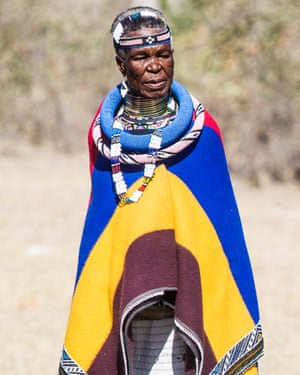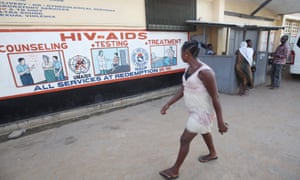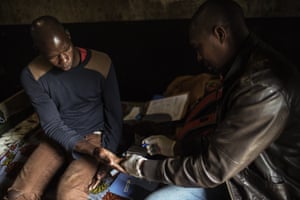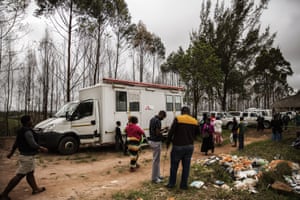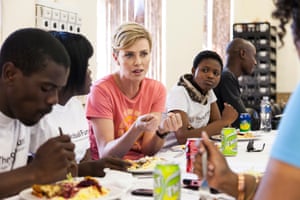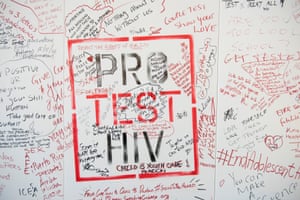In 33 years of the Aids pandemic, which has maybe brought on more shock and anguish than any other infectious disease given that the black death, only one person has ever been cured. That guy was “the Berlin patient”, now identified as Timothy Ray Brown, an American handled in Germany, whose case was publicised in 2009. Until last week, the globe hoped that a small youngster had joined him, but the Mississippi child, now almost four many years old, is back on antiretroviral drugs after two tantalising many years when normal exams failed to discover any trace of the HIV virus in her body.
At the Worldwide Aids Conference that opens in Melbourne, Australia, on Sunday, the relapse of the Mississippi child will figure in considerably of the conversation on and off the platform. Drug remedy, now reaching nearly 13 million individuals, has stabilised the Aids epidemic in most countries, but it is high-priced, and may be unsustainable due to the fact it needs huge efforts from overstretched health systems, specially in establishing countries. Death charges are minimizing – all around 1.5 million last yr – but whilst new infections have dropped by much more than a third considering that 2001, when there have been 3.4 million, nevertheless two million individuals are infected with HIV every single year. More and more, Aids is turning out to be a bigger concern in marginalised populations who are harder to reach and might live on the fringes of their societies – sex staff, guys who have sex with men in nations this kind of as Uganda, the place homosexuality is not tolerated, and drug users in eastern Europe.
Attempts to develop vaccines over the last three decades have proved fruitless. In 1984, when the virus was identified, Ronald Reagan’s upbeat head of overall health and human providers, Margaret Heckler, predicted a vaccine inside of two many years. Huge sums of cash have gone into trials of distinct candidates, but in spite of the occasional burst of pleasure, none has been shown to perform properly adequate. The latest piece of hopeful information came last September, when scientists explained they had managed to protect 9 out of 16 rhesus monkeyswith a vaccine – but trials in animals have previously shown great benefits that did not translate into safety for people.
So scientists in the final couple of many years have rallied close to a new flag – that of a remedy for Aids. Brown and that nameless minor woman in the deep south of the US demonstrate just how challenging to achieve that will be.
Brown was the exception that proves the rule. In 2006, possessing been HIV positive and on therapy for above ten many years, he was diagnosed with acute myeloid leukaemia. He necessary a bone marrow transplant to change his own cancerous cells with stem cells that would remake his immune method. His doctor, Dr Gero Hütter, at the Charité hospital in Berlin, was in a position to find him a extremely particular and uncommon donor: somebody who was naturally resistant to HIV infection due to a genetic mutation that blocks HIV from getting into the cells in the human entire body.
Brown had two stem cell transplants from the donor, in 2007 and 2008. The HIV virus disappeared from his body and it has been undetectable ever since.
Stem cell transplants, however, were by no means going to be the response. They are hard and probably dangerous for the recipient, and only undertaken where they could conserve a lifestyle. It was Brown’s cancer that threatened his existence and justified surgical treatment, not HIV. Hopes, however, were cautiously large when two other males with HIV and cancer – duly nicknamed “the Boston patients” for the city in which they have been handled – also underwent bone marrow transplants, one particular in 2008 and one particular in 2010. In July 2013, their physicians mentioned they had the two stopped their medicines, 1 for 15 weeks and a single for seven, and had no detectable virus in their blood. They might have been cured, the doctors explained. Six months later on it was announced that the virus had returned. The lucky break for Brown had been to find a donor who was each compatible with him and resistant to HIV infection – an amazingly rare blend. The Boston patients have been not so fortunate.
But nonetheless there was the Mississippi child. She was born in 2010 to a mother who had never ever attended an antenatal clinic. Nobody knew she was HIV constructive till she was in labour. Dr Hannah Gay, the paediatric HIV advisor at the Jackson Memorial Hospital, took an unusual choice. With no waiting for the exams that did eventually confirm the infant had the virus, she place her on a robust program of antiretroviral medication. The baby was on treatment inside of 30 hours of her birth and stayed that way until the hospital misplaced make contact with with the mom 18 months later on.
When mother and kid reappeared five months later on, the little one had no detectable virus in her blood. The case, published in the New England Journal of Medicine, induced massive excitement in the scientific and campaigning HIV planet. A new hypothesis was born – that hitting the virus quite early in the infection might by some means prevent it taking hold. It seemed plausible. A second baby was handled in California within four hrs of birth and is even now on the drugs.
When the announcement came that, two many years on, the Mississippi baby’s virus had re-emerged, some known as it a disappointment, some a setback, whilst others insisted it was component of a learning curve. HIV scientists have realized to be resilient and to guard towards false hope, but there is little doubt that the mood of the Melbourne conference will be a little much less upbeat simply because of the information. Anthony Fauci, director of the National Institute of Allergy and Infectious Conditions in the US, said: “Definitely, this is a disappointing turn of events for this youthful youngster, the health-related staff involved in the child’s care, and the HIV/Aids investigation community. Scientifically, this advancement reminds us that we nonetheless have considerably a lot more to discover about the intricacies of HIV infection and where the virus hides in the entire body.” His institute, at the forefront of HIV science, “stays committed to moving forward with research on a cure for HIV infection”.
 Timothy Ray Brown stays the only person to have been cured of Aids, and that was thanks to an incredibly uncommon and lucky mixture of aspects. Photograph: TJ Kirkpatrick/Getty
Timothy Ray Brown stays the only person to have been cured of Aids, and that was thanks to an incredibly uncommon and lucky mixture of aspects. Photograph: TJ Kirkpatrick/Getty
HIV, as the vaccine researchers know to their cost, is as formidable a foe as science has ever encountered. It is capable to hide itself in the body the place hugely sophisticated contemporary testing are not able to find it. Each and every time it appears that drugs have coshed it out of existence and the remedy is stopped, it reappears. There are reservoirs we can’t detect.
Dr Sarah Fidler from Imperial University London is 1 of the HIV researchers concerned in the hunt for a cure. She is doing work on a trial, due to start off subsequent yr, which will endeavour to trick the virus into emerging from its hiding spots and then set off the body’s immune system to recognise it and attack it.
In spite of all that was said, nobody could be fully sure that the Mississippi child had ever been free of the virus, she says. HIV inserts its DNA into the patient’s cells. There was no active virus, but there have been traces of the virus’s DNA. You don’t know, she says, whether or not it will actually be expressed as “true-existence virus”, especially with a child, due to the fact you cannot consider large adequate blood samples for the needed tests.
“For some of the blood tests you are taking 300ml from an grownup”, she says. “There may be one particular in a million or a single in 10 million cells that have virus in them.”
The announcement from the US is, Fidler says, “a extremely big disappointment”. But she nevertheless discovered it surprising that the viral levels in the child remained as low as they did for the duration of the time she was not acquiring therapy.
She thinks that really early treatment method could possibly support knock out the virus, but there are practical problems even with babies, allow alone grownups. To treat babies inside hrs of their birth – which is when they become contaminated – you want to have the medication obtainable each time and wherever the delivery of somebody with unknown HIV takes area, which could be at residence. Adults could not know when they have been contaminated – and if they do, are unlikely to race to the hospital within hours.
Up coming year’s trial to flush out the virus and prompt the immune method to recognise it is a huge collaborative effort, involving 5 top British universities and funded by the Medical Research Council. About 50 volunteers, all lately infected with HIV, will take drugs till the virus is practically undetectable, and then be provided a drug – generally employed in cancer treatment method – to make it reveal itself. They will also obtain a therapeutic vaccine that will assist the immune system recognise the virus. It is an technique that has been known as “kick and kill”.
Fidler says she does think there is progress in direction of a remedy. “I think we have a much greater understanding of the virology and the immunology. There’s a good deal of in-vitro [test tube] perform.”
There is more than one accepted definition of “remedy” in the Aids context. Experts at the International Aids Society, the organisers of the Melbourne conference, talk of a “sterilising cure”, the place HIV is eradicated from the entire body, as they hope has occurred in Brown’s case and a “functional remedy”, the place HIV remains at a really low level with no progression. That is the circumstance with the “Visconti cohort”, a group of 14 folks in France who were provided medicines extremely early, inside a handful of weeks of getting to be contaminated (standard practice employed to be to wait until finally the patient’s immune program started to be depleted) and have been closely followed ever given that. They stayed on therapy for 3 years, on typical, and then stopped the drugs. Following about seven years, the quantity of virus in their blood remains quite low and their immune method is functioning well. They are said to be “functionally cured”, even though experts cannot be specific they are not people who would by no means have grow to be significantly ill anyway. There are men and women termed “elite controllers” who, apparently for genetic motives, can be exposed to HIV infection and never become ill. Those incorporate a group of ladies doing work in Nairobi’s red light district who have been often exposed to customers with HIV and nevertheless have not designed it themselves.
Some of the very best information in current years has been that the antiretroviral drugs to hold the virus at bay can also defend the partners of people with HIV. Because they depress the viral load to virtually undetectable ranges in a person with HIV, it is hugely unlikely it can be passed on. It follows that the more folks all around the globe we can get on therapy, the fewer new infections there ought to be. The medication can also protect men and women with no HIV who are obtaining a sexual relationship with someone who is infected. The Globe Overall health Organisation last week strongly suggested that males who have sex with guys consider taking the single day-to-day mixed drug pill as a indicates of protection.
There is a lot of cause to celebrate the achievements of the last 33 years, and plenty of hope for the potential, so this week’s conference will not be a gloomy event. The pandemic can be managed, that significantly we know. Whether or not a cure – functional or otherwise – is achievable is tough to say, provided last week’s news. But the scientists heading along that path are established to give it their best shot.
Kick and destroy: is this the ideal new hope for an Aids remedy?
